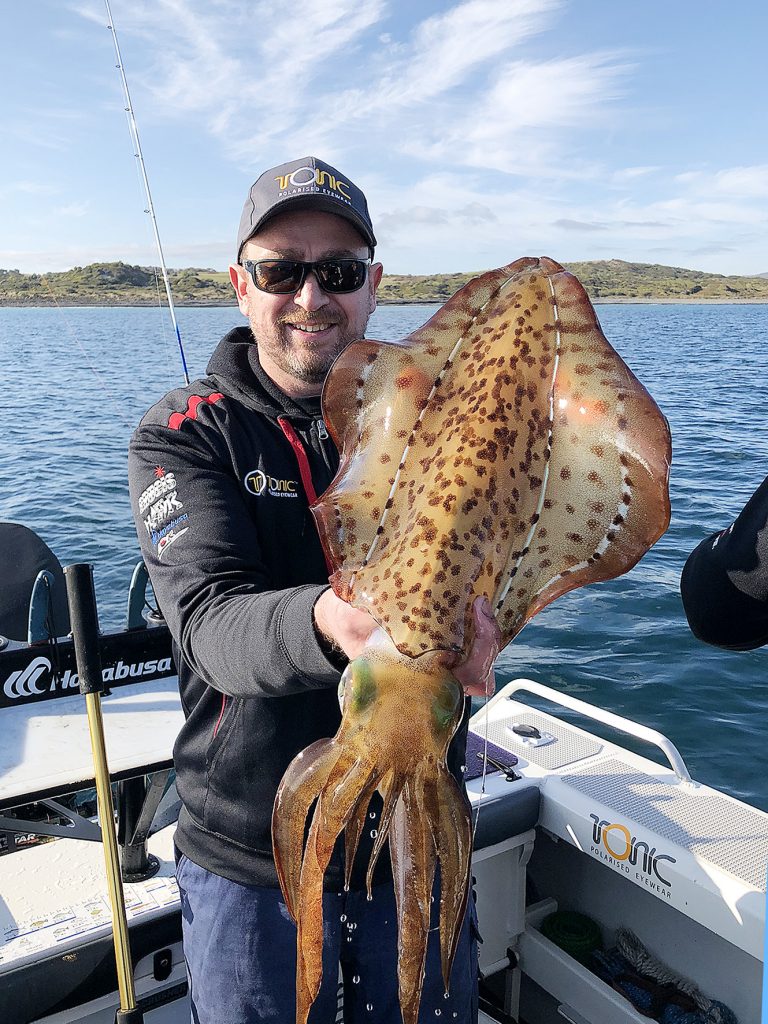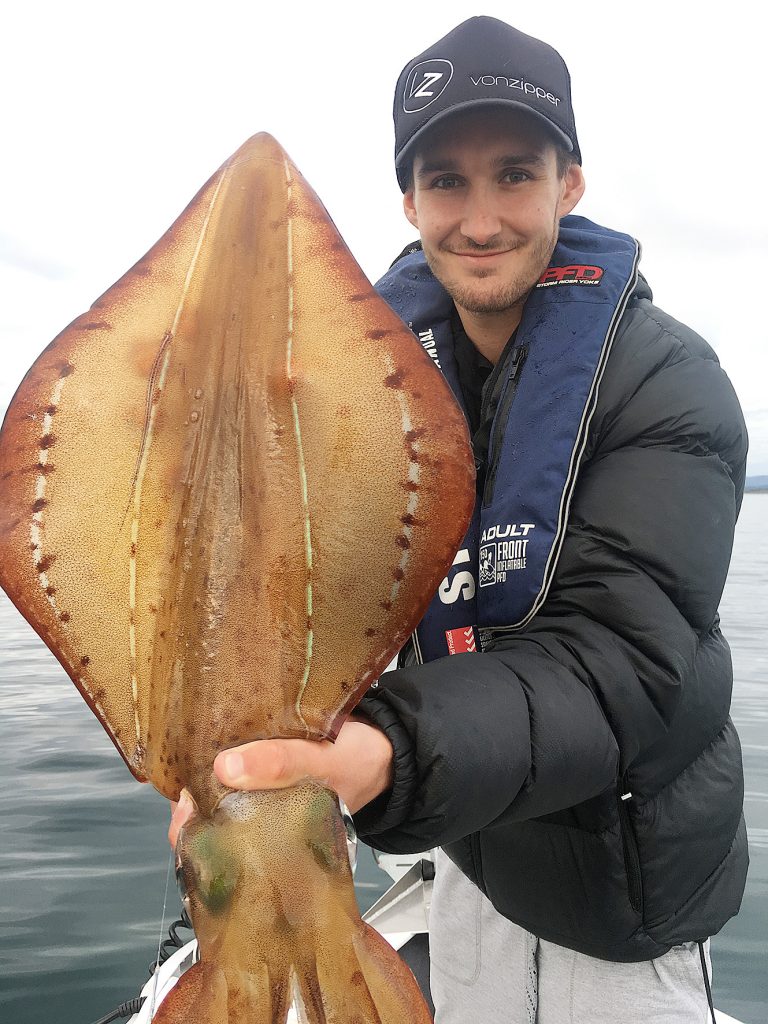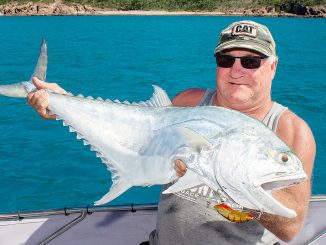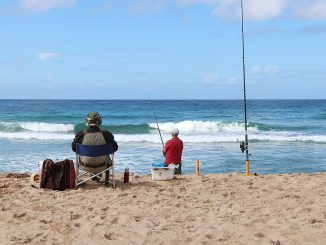
by Matt Sherriff •
Fishing for squid over the last few years in Tasmania has become increasingly popular. Not only are these strange looking creatures great fun to catch, they are also exceptional on the plate. Regardless of whether you have a boat or are shore-based, you generally do not have to travel too far to find a feed.
When squid are on the chew, they will aggressively hunt down almost any jig thrown at them and you can usually put yourself amongst the action using a basic rod and reel combo or even a handline. However, this isn’t always the case and sometimes a change of technique and equipment is required to help you to extract some of these tasty morsels from the water. One such option is the Japanese style of squid fishing with an egi.

ROD
An egi rod will be around 8’ and usually comes in 2-4kg or 3-5kg ranges. The 2-4kg rods are suited to size 2.5-3.5 jigs and the 3-5kg rods are better for 3.0-4.0 sized jigs. These rods have a relatively stiff tip for imparting action to the jig and are parabolic for dealing with lunging squid without ripping the spikes of the jig out of the squid. A parabolic rod will bend in a large U-shaped arc across its length, unlike the fast-tapered rods that are suited to lure and plastics fishing where the top third of the rod is the only part that really bends over.
Egi rods are generally fitted with low rider guides, as unlike normal lure spinning where a lure loses speed very quickly, squid jigs maintain a high speed for a long distance when cast. These guides are designed for casting long distances while eliminating any line wrap when using soft braided lines. Good rods are made of high modulus carbon and will have good sensitivity and be very light in hand. I use both the Crucis Egi Ink (3-5kg) and the Lox Egi AU7924 (2-4kg).
REEL
All you need is a 2000-3000 size reel that is braid friendly and has a smooth drag. The reel does not need a large line capacity unless you intend to use it on other pelagic fish. The best advice I could pass on with reels is to try it on the rod before buying to make sure it balances up well. I often use Crucis Carbon reels but have recently been testing the new Pioneer Cyclones and have been happy with the results.
LINE
Braided line is a must for this style of fishing, as the lack of stretch is critical to not only impart action on the jig but also to detect strikes. I prefer to run fluoro orange or green line, as it stands out and you can easily see subtle movements in the line indicating a take. As far as breaking strain goes, I generally run 12lb braid with a 12lb shock leader of around 2m in length. Previously I have run an 8lb leader, but I have not found the 12lb to be disadvantageous with squid plus it gives a better chance of retrieving a jig if it gets snagged up.
JIGS
There are many high-end jigs on the market these days, ranging up to $30. These jigs may seem expensive but if squid are playing hard to get, they can be the difference between a good day and a slow one. Good jigs will have high quality cloth that is ultra-reflective, with most being UV enhanced. These jigs will also have an attractive sinking action. The Hayabusa 3.5 jigs I use have a sink rate of just over 3 seconds per metre, allowing me to count the jigs down to get into the zone.
In regards to colours, if you’re fishing with others it is best to all be using different colours to start with before changing to the ones working best on the day. Many anglers prefer red foils for low light periods and gold foils as the sun gets up but as with all fishing, it depends on the day in question.
NET
While any net will do, large mesh rubber nets work best as jigs don’t tend to get tangled up in them and they are very good at dispersing the ink. A quick swish through the water is all that’s needed to get any remaining ink from the mesh after boating your catch.
GLASSES
We all know to wear glasses when we’re fishing to protect our eyes, but do you wear high quality polarised eyewear? A good pair of glasses is nearly as important as your fishing rod and you will definitely catch more squid wearing some!
I look for a pair that are scratch resistant as well as photochromic, meaning the lenses will darken slightly in bright light and lighten up in overcast or darker conditions. Being able to see squid following your jig not only helps improve your catch rates but will also give you an understanding of how they react to the movements of the jig. Once you have their attention and they have followed up your jig, most of the time it is just a simple case of feeding the jig back down to them to entice a strike.

TECHNIQUE
Most of us are used to throwing out a jig, letting it sink and just giving the rod a slow lift and drop to work the jig. With the egi style of fishing, you need to become a little more active. Cast out your jig and let it get to the desired depth. If you’re drifting, cast forward and off to the side of your boat to allow your jig to sink faster. One of the most important things to do is to get your jig within a foot or so of the bottom, as this will entice squid up from the cover of the weed.
The next step is where the technique differs. You now impart the action on your jig with two or three erratic/violent jerks, which will make the jig dart up like fleeing or injured prey. After this, allow the jig to sink back down to the bottom by dropping the tip of your rod while maintaining contact with the jig by winding in any slack line. The initial action of the jig will get the interest of squid and bring them over to your jig, and then they will grab it as it begins to fall back down.
It is important to keep the slack out of your line and watch it intently as it drops (bright line is extremely helpful for this) to see if there are any changes indicating a strike. If you suspect a hit, strike immediately and drive the spikes home. This technique will also increase the life of your jigs, as squid don’t have time to pull the jig in and take a chunk out of the material with their sharp beaks.
OTHER TIPS
Squid have big eyes and hunt primarily by sight. Clear water is paramount to successful squid fishing and calm conditions will often give the best results. After heavy rains or big seas, it is often best to let things settle before you plan a trip to avoid disappointment.
If it’s a tough day, sometimes anchoring in an area where you’ve picked one or two up and then using some berley will improve results. Berley will often attract small fish such as gars or mullet, which will then attract the squid and keep them in the area.
Sometimes you can be out for an hour or so with only one squid to show for it, and then in the next half an hour you can catch 20 or 30. It’s important to be patient and keep at it, as like all fish there will be certain times where they feed hard or go off. I’ve found they tend to shut down when the tide stops running, so it’s a great time to grab a bite to eat in between sessions.
Make sure you give them some time to expel their ink before you land them unless you don’t mind a face full of the black stuff. It also pays to point them away from you when netting and never wear any clothes that you aren’t prepared to sacrifice! Dispatch your catch quickly by squeezing tightly between the head and tube or using a spike to the brain (with a squid specific spike). This will stop the squid regenerating ink and help make it less messy come cleaning time.
While I’ve always loved catching and eating squid, the one task I’ve never been fond of is cleaning the messy critters. These days I use a purpose designed cleaning bag, which eliminates pretty much all of the mess and saves heaps of time!
Hopefully this article gives you some inspiration to give the egi style of squid fishing a crack! This is not only a fun way to target them, I can also guarantee it will see you filling the bucket quicker than before, especially on tough days.



